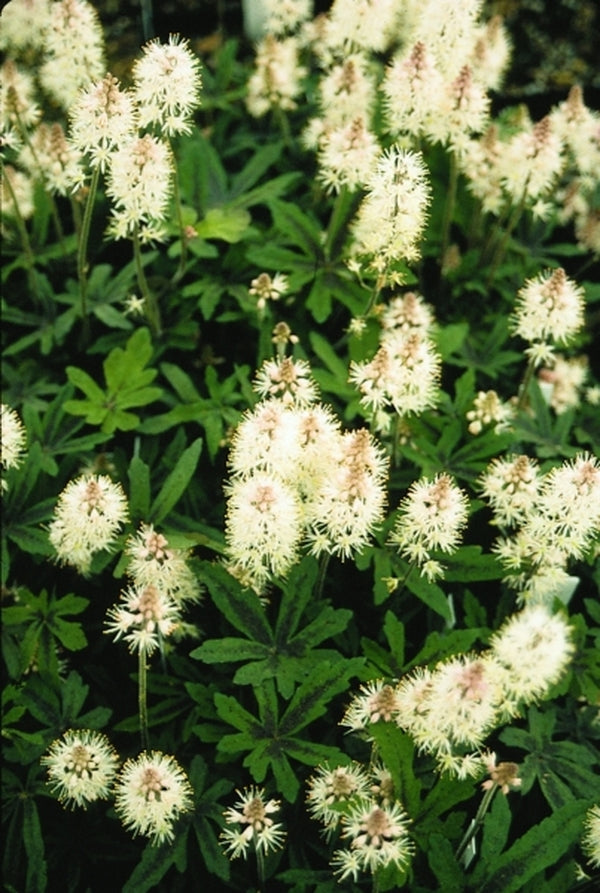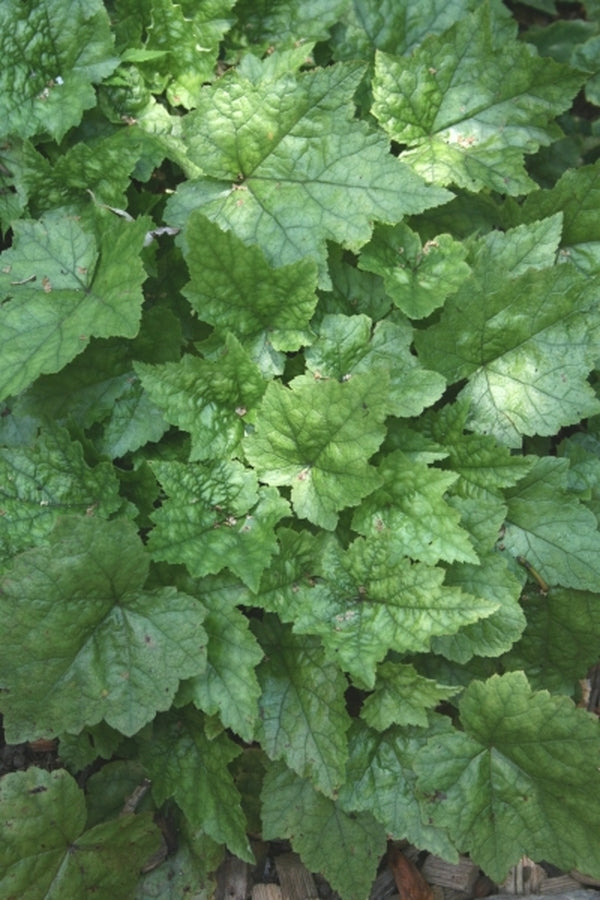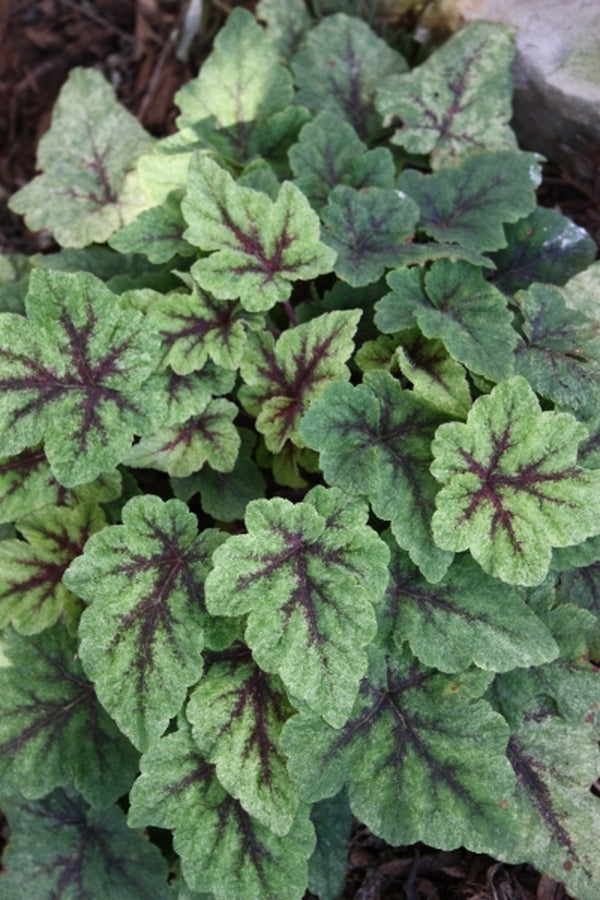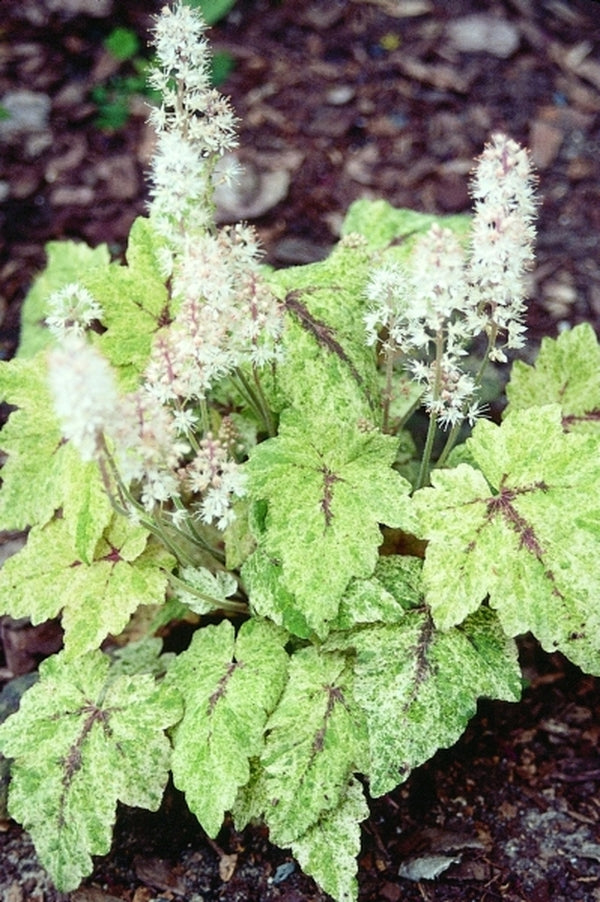Introduction to Tiarella (Foam Flowers)
The genus tiarella is a charming, shade-loving foliage plant for the woodland gardens. Tiarellas produce sprays of small, attractive flowers on top of a short mound of green foliage. In the last 15 years, an enormous number of new cultivars have been developed and made available to gardeners, so there has never been a better time to collect and grow these wonderful woodland perennials.
How to Grow Tiarella
Tiarella are better for deep shade than their cousin heuchera but prefer the dappled sunlight found in shaded woodland gardens. In deep shade their foliage color may fade. In North Carolina, a site with 3-5 hours of dappled sunlight per day is perfect. Foam flowers prefer the pH in soils to be close to neutral and in order to pair them with more acid lovers, we recommend a pH of 6.2 - 6.5 that will allow all plants to be grown equally well.
Tiarella are low maintenance plants and can remain undivided for years in the garden without losing vigor. If they become tattered looking due to weather extremes, they can be cut back for rejuvenation, but this is not necessary.
The astringent Tiarella leaves are generally left alone by deer and rabbits, but remember that in the middle of the winter a ravenous deer or rapacious rabbit will eat anything, including Tiarella. Foam flowers are generally not affected by insect pests. Occasionally black vine weevils can infest the plant, boring into the crown and killing the tops. Black vine weevils are controlled by systemic insecticides but if untreated, they will eventually kill the plant. Gardeners may sometimes see mealy bugs or slugs but they are easily controlled with commercial products. Rarely, foliar nematodes will cause ugly discolored patches on the leaf. There is no control for nematodes...avoidance is the key. Buy plants only from nurseries that scout for and remove infected plants.
Tiarella grow quite well in shade garden containers. They like well drained potting mixes without a lot of fertilizer. Keep the pots well watered in the summer but do not over-water in the winter. The pots will need some protection from cold winter winds.
How to Propagate Tiarella
Foam flowers are easy to propagate from seed. The plants are generally self-sterile, so gardeners who want seed will need to plant more than one species or cultivar. The flowers appear in the summer and the seeds will be ready six weeks after pollination when seed pods will turn brown and then split open. The seed can be collected and sown immediately. Germination should occur within 30 days and the seedlings will be ready to pot up by fall. The seeds may also be dried and stored for up to a year.
Tiarella naturally produces offsets on stolons which can be used to produce more plants. After their second season, the offsets form their own roots. When the plant has reached its third year, you can dig up the clump, wash away the soil, and pull off the rooted offsets. The smaller offsets may need to be potted and placed in a cold frame during their first winter. You can also collect the offsets before they have rooted and treat them like stem cuttings. They will root easily without any rooting hormone as long as they are protected from desiccation by a mist bench or a plastic dome. With a little more care, you may also have success by removing a leaf at the base along with a small piece of stem tissue and rooting the leaf/stem cutting.
The great majority of commercially produced Tiarella start life in tissue culture. Growers start with buds, leaf petiole bases, or even pieces of the flower stalk and can create plantlets in only a few weeks.
Taxonomy
Tiarella are commonly known as foam flowers, because their masses of tiny, spidery flowers atop short stalks collectively look like foam on a stick. The genus is native to eastern North America (Tiarella cordifolia and Tiarella triphylla) and Asia (Tiarella polyphylla). The East Coast Tiarella cordifolia is further subdivided by some taxonomists into three varieties: Tiarella cordifolia var. austrina (Virginia south to Georgia), Tiarella cordifolia var. collina (Maryland south to Mississippi), and Tiarella cordifolia var. cordifolia (Canada south to Georgia). The varieties are based on leaf size, shape, and the presence or absence of stolons. Unfortunately, the plants don't always cooperate with the taxonomists, and the splitting of Tiarellas into these varieties simply doesn't hold up across their range.
Tiarella are closely allied with the genus heuchera and can be hybridized with it to make the intergeneric hybrid x heucherella. In the wild, foam flowers are generally found in woodland or mountainous (montane) environments. Like heuchera, Tiarella like dappled shade but prefers a moister habitat than its botanical cousin.
The genus name Tiarella comes from the Latin word "tiara" (an upright Persian crown) and "-ella" (diminutive) which refers to the small turban-shaped dry fruit (a capsule). Tiarella belongs to the family Saxifragaceae which contains other ornamental plants such as Astilbe, Astilboides, Bergenia, Boykinia, Mukdenia, Saxifraga (Strawberry Begonia) and Rodgersia. The name Saxifragaceae comes from the Latin words "saxum" (rock) and "frangere" (break). Plants in this family are often seen growing in cracks and crevices of stony places and their roots are thought to contribute to the erosion and breakdown of rocks.
Morphology
Tiarella is an herbaceous shade perennial that grows a clump of leaves from a central crown held at or just below the soil surface. Each node on the crown contains a bud that will eventually form a new leaf, an inflorescence, or a stolon that gives rise to an offset. Tiarella stolons can be quite long and allow the plant to spread throughout woodland gardens as a ground cover. Foam flowers can either be clumpers or wide spreaders.
Tiarella leaves have 3-9 lobes which can be rounded like columbine (aquilegia) or angled like a red maple leaf. The sinuses between the lobes may be shallow or deeply cut like a Japanese maple. Tiarella leaves are generally semi-evergreen but the rosettes of the leaves often turn a reddish bronze while becoming flattened in the winter. The primary ornamental feature of Tiarella leaves is their color, which is usually green with an occasional prominent maroon or purple branched central vein (called a feather).
Tiarella "flowers" are actually inflorescences; a collection of many small bell-shaped or spidery florets on a single floral structure. The foam flower stalk (peduncle) arises from the crown and stretches 1-2 times the height of the leaf canopy. Tiarella inflorescences are arranged as a tight cylindrical brush (like a bottle brush) with several dozen branches, each containing only one or two closely spaced florets. Foam flower florets are only a few millimeters across and are usually downward or outward facing. Each tiny floret is 5-lobed with narrow petals that spread into a star shape and their anthers usually extend beyond the petals and provide a feathery appearance. Colors include greenish-white, white, pink, and coral.
The inflorescence buds are formed during the summer but they do not grow and open until after they have been exposed to 10 or more weeks of cold temperatures the following year. Wild foam flower species have a flowering period of 3-6 weeks but the newer hybrids have been selected for improved duration and may bloom for months. One of our favorites here at Plant Delights Nursery and Juniper Level Botanic Gardens is Tiarella 'Pink Skyrocket' which has a dazzling display of pink and white flowers.
Tiarella Breeding Programs
Modern breeders have been very busy releasing dozens of cultivars of Tiarella in a short time. These new perennials display foliage variants and flower combinations that have never been seen before. Prominent Tiarella breeders include Dan Heims of Terra Nova Nursery in Oregon, Charles and Martha Oliver of The Primrose Path Nursery in Pennsylvania, and Sinclair Adam of Dunvegan Nursery also in Pennsylvania.
In the mid 1990s the folks at Terra Nova started making seedling selections from their initial Tiarella collection and have since released many new hybrids to the commercial market. Terra Nova Nursery has been the leader in the world of Tiarella introductions, starting in 1997 with Tiarella 'Ninja' PP 11,168. Over the next 10 years, they introduced 17 additional cultivars including Tiarella 'Cygnet' PP 11, 051 (1998), Tiarella 'Spanish Cross' PP 11,345 (1998), Tiarella 'Mint Chocolate' PP 11,379 (1998), Tiarella 'Crow Feather' PP 12,335 (2000), Tiarella 'Black Velvet' PP 12,348 (1999), Tiarella 'Iron Butterfly' PP 12,396 (2000), Tiarella 'Spring Symphony' PP 12,397 (1999), Tiarella 'Starfish' PP 13,148 (2001), Tiarella 'Neon Lights' PP 13,289 (2001), Tiarella 'Pink Skyrocket' PP 13,382 (2001), Tiarella 'Jeepers Creepers' PP 13,437 (2001), Tiarella 'Black Snowflake' PP 13,684 (2002), Tiarella 'Sea Foam' PP 13,696 (2002), Tiarella 'Pirate's Patch' PP 14,907 (2003), Tiarella 'Candy Striper' PP 15,528 (2003), Tiarella 'Sugar and Spice' PP 16,738 (2005), and Tiarella 'Morning Star' PP 17,486 (2005).
The Olivers started working with Tiarella in 1998 and have been selecting for deeply divided leaves and tolerance to heat and humidity. Their work hit the market in 2001 with Tiarella 'Pink Brushes' PP 13,329, followed by Tiarella 'Pink Pearls' PP 13,445 (2001), Tiarella 'Butterfly Wings' PP 13,629 (2001), and Tiarella 'Running Tiger PP 15,360 (2004).
Similarly, native flora expert and plant hunter extraordinaire, Dr. Don Jacobs of Eco-Gardens in Decatur Georgia, has made many selections of Tiarella since the 1970s including Tiarella cordifolia 'Eco Running Tapestry', Tiarella cordifolia 'Eco Eyed Glossy', and Tiarella cordifolia 'Eco Red Heart'.
Tiarella Species, groups and Cultivar List
Tiarella 'Black Velvet' PP#12,348 (Black Velvet Foam Flower) Tiarella 'Black Velvet' has deeply lobed leaves that are green with black veins and bluish white flowers. (Hardiness Zone 3-9)
Tiarella 'Brandywine' (Brandywine Foam Flower)Tiarella 'Brandywine' has glossy green leaves that turn bronze in winter and large sprays of creamy white flowers. The plant spreads slowly to form a nice 10" clump with time. (Hardiness Zone 3-8)
Tiarella 'Butterfly Wings' PP 13,629 (Butterfly Wings Foam Flower) This amazing new introduction from Primrose Path is the most unique foam flower that we have seen. The lacy, heavily dissected foliage is marked with a dramatic black central pattern, which looks more like a high-dollar hardy geranium than a Tiarella. Each of these vigorous, 1' tall, clumping, foam flowers is topped with clusters of light pink flowers in April. This is a must-have plant for the woodland garden. (Hardiness Zone 3-9)
Tiarella cordifolia (Foam Flower) This lovelynative woodlander forms rosettes of fuzzy green leaves, giving rise to numerous 12" spikes of smallwhite flowers...absolutely awesome when used in a mass in the woods. (Hardiness Zone 3-9)
Tiarella cordifolia 'George Shenk Pink' (George Shenk Pink Foam Flower) This is a light pink-flowered form of foam flower that is a delight in any woodland garden. The base is the same fuzzy, green, 1' tall clumper that we all know and love... only the flower color has been changed to protect...whomever. (Hardiness Zone 3-9)
Tiarella cordifolia 'Oconee Spreader' (Oconee Spreader Foam Flower)(syn: A11NC-053) This vigorous ground cover selection of foam flower is one that we discovered in 2000 while botanizing in the Oconee region of Pickens Co. in upstate South Carolina. In the garden, the glossy, green leaf, 10" tall rosettes spread nicely, forming a large 8' wide patch in 5 years. In spring, the clumps are topped with bottlebrush-like spikes of white. (Hardiness Zone 5-8)
Tiarella 'Crow Feather' PP#12,335 (Crow Feather Foam Flower) This Terra Nova introduction boasts deeply lobed green foliage with purple markings in the middle. In winter the leaves take on shades of pink, red, purple and black. The clumps are topped with pink bottlebrush-like flowers in early spring. (Hardiness Zone 3-9)
Tiarella cordifolia 'Dunvegan' (Dunvegan Foam Flower) From Dunvegan Nursery comes this spectacular foam flower with dissected 5-7 lobed leaves...resembling the hand of an extraterrestrial! Tiarella 'Dunvegan' makes a nice compact clump to 1' tall x 1' wide with stalks of very pale pink flowers in early spring. A nice addition is that the new foliage is tinged purple...great in a mass planting! (Hardiness Zone 3-9)
Tiarella cordifolia 'Eco Eyed Glossy' (Eco Eyed Glossy Foam Flower) This seedling from the garden of Don Jacobs is known for its glossy foliage, quite a change from most early foam flower selections. The 1' tall x 1' wide clumps have the typical white flowers just above the foliage during the spring...great in the woodland. (Hardiness Zone 3-9)
Tiarella cordifolia 'Eco Rambling Silhouette' (Eco Rambling Silhouette Foam Flower) This is another wonderful seedling from the garden of Don Jacobs, with a very dark reddish purple center pattern on each deeply cut, glossy leaf. This 12" tall running foam flower is topped with a mass of white flowers in early spring...a great ground cover. (Hardiness Zone 3-9)
Tiarella cordifolia 'Eco Red Heart' (Eco Red Heart Foam Flower) This Don Jacobs selection is known for its brilliant burgundy patterning in the center of each leaf. As with most foam flowers, it forms a 1' tall x 1' wide clump, topped with fragrant white flowers just above the foliage during the spring. A mass planting is absolutely charming! (Hardiness Zone 3-9)
Tiarella cordifolia 'Eco Running Tapestry' (Eco Running Tapestry Foam Flower)This Tiarella from the garden of Pennsylvania's Dot Plyler, has fuzzy green, nearly round leaves emblazoned with a fabulous large black pattern extending far out from the veins. This is a runner (not the long distance kind) but soon forms a great ground cover in the woodland garden. The typical white, 1' tall bottlebrush-like flowers top the 6" tall mat in early spring. (Hardiness Zone 3-9)
Tiarella cordifolia 'Eco Splotched Velvet' (Eco Splotched Velvet Foam Flower) This Don Jacobs selection of foam flower from northwest Georgia, is recognized by its velvety textured leaves, with a dark reddish purple pattern at the base of each leaf...fragrant pale pink flowers top the 1' tall clump in early spring. (Hardiness Zone 3-9)
Tiarella 'Elizabeth Oliver' (Elizabeth Oliver Foam Flower) An older cultivar but still very nice has lobed green leaves have purple markings in the center. Light pink fragrant flowers are showier than most cultivars. Spreads slowly to 12" wide. (Hardiness Zone 3-9)
Tiarella 'Filigree Lace' (Filigree Lace Foam Flower) This delightful new selection comes from Charles Oliver at Primrose Path. Tiarella 'Filigree Lace' has deeply lobed foliage, cut almost to the center of the leaf. Each leaf has a distinctive dark purple pattern at the base. Each 1' tall clump spreads to almost 18", making a great mass planting for any woodland garden...typical white flowers just above the foliage in spring. (Hardiness Zone 3-9)
Tiarella 'Jeepers Creepers' PP 13,437 (Jeepers Creepers Foam Flower)This new Terra Nova introduction upgrades the creeping forms of foam flower. Instead of forming a tight clump, Tiarella 'Jeepers Creepers' makes a nice weed-suppressing 8" tall groundcover to 2-3' width. The deeply lobed, fuzzy, green leaves are each highlighted by a dramatic wide black vein pattern. In late spring, the mats are topped with white bottlebrush-like flowers. Tiarella 'Jeepers Creepers' is perfect as a backdrop for trilliums and other woodland bulbs. (Hardiness Zone 3-9)
Tiarella 'Laird of Skye' (Laird of Skye Foam Flower) This new selection from Dunvegan Nursery has three lobed leaves with a nice ruffled edge. The nice white flowers are much larger than the typical species and rise 10" above the foliage...visitors will truly gawk over a nice 6" tall patch of this foam flower. (Hardiness Zone 3-9)
Tiarella 'Mystic Mist' PPAF (Mystic Mist Foam Flower) This exciting Terra Nova introduction makes a 5" tall by 1' wide clump of white frosted, maple-shaped leaves, each highlighted with wide, dark-purple central veins. The clumps are topped with short bottlebrush spikes of white flowers in early spring. We are very impressed with the improved vigor over earlier variegated foam flowers. (Hardiness Zone 4-8)
Tiarella 'Neon Lights' PP 13,289 (Neon Lights Foam Flower) This Terra Nova hybrid has one of the most distinctive leaf patterns that we have seen. The deeply cut fuzzy green foliage is highlighted by a magnificent black-purple pattern that mimics the leaf form. In mid-spring, the 22" wide clumps are topped with 16" flower spikes of white...stunning even when not in flower! (Hardiness Zone 4-9a)
Tiarella 'Pink Skyrocket' PP 13,382 PVR (Pink Skyrocket Foam Flower) This 2002 release from the Terra Nova breeding program is the best pink-flowered foam flower we have seen. The 8" tall x 1' wide clump of strongly dissected, shiny green foliage, highlighted with a central black blotch, is topped in late spring with a dazzling display of 1' tall pink "brushes." (Hardiness Zone 3-9a)
Tiarella 'Pirate's Patch' PP 14,907 (Pirate's Patch Foam Flower) Each fuzzy green leaf is highlighted by a dark central pattern of black. Each 5" tall by 1' wide clump is topped in late spring with a stunning display of 10" tall white bottlebrush-like flowers...hovering just above the foliage like a Texas buzzard over road kill. The breeders at Terra Nova have counted 250 flower spikes on a 3 year old plant...pretty dazzling! The winter foliage is a nice shade of bronze. (Hardiness Zone 3-9a)
Tiarella polyphylla 'Heronswood Mist' (Heronswood Mist Foam Flower) This foam flower was discovered as a seedling from a Dan Hinkley collecting trip to Yunnan, China. Instead of having the normal green foliage, each fuzzy leaf is heavily dusted with a cream frosting...like a green leaf decorated with one of Martha Stewart's famed faux patinas. As the nights cool, the foliage takes on a pink overtone which adds to the uniqueness. In spring, each 8" tall x 1' wide clump is topped with the typical bottlebrush-looking white flowers. (Hardiness Zone 5-7)
Tiarella polyphylla 'Moorgrun' (Moorgrun Foam Flower) This foam flower from Asia resembles our native, with the same grape-shaped fuzzy green leaves. Instead of forming a clump, it spreads into a wonderful, fuzzy green 10" tall groundcover...if you've got the itch, roll around in this one for a while. The mat is topped with short, white, bottlebrush-like spikes in early spring. (Hardiness Zone 5-9)
Tiarella cordifolia 'Slickrock' (Slickrock Foam Flower) This introduction was found by Jim Plyler near Slickrock Creek in North Carolina. The small maple-like leaves are about half the size of other Tiarella. In addition, Tiarella 'Slickrock' spreads much faster than any other Tiarella we have grown...a truly social shade perennial. In the spring, the 6" spires of light pink adorn this 6" tall woodland mat...very special! (Hardiness Zone 3-9)
Tiarella 'Spring Symphony' PP 12,397 (Spring Symphony Foam Flower)This Terra Nova introduction may well be the best clumping Tiarella that we have grown. The jagged, fuzzy green leaves are each highlighted by a black central blotch. In April (NC), the compact 1' tall clumps are topped with 1' tall, light pink, bottlebrush-like flowers... darker toward the tips. A mass of Tiarella 'Spring Symphony' is stunning in the woodland garden. (Hardiness Zone 3-9)
Tiarella References
Oliver, C., and Oliver, M. (2006), Heuchera, Tiarella, and Heucherella: A gardeners guide, B T Batsford Press.
Rice, G., (2009), Mining the potential of Shade-loving Natives, The American Gardener, March/April issue, Pp. 24-28.
Be sure to check out all of our available Tiarella for sale.









